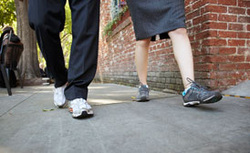 Results from a nationwide survey show that 79% of individuals surveyed know they should be walking more. Additionally, 94% of survey respondents know walking is good for their health. The 2013 Walking Survey also found that 73% of respondents think their children should be walking more. According to the survey, 30% of Americans said they walk more than they did five years ago, 35% are walking less and 32% are walking about the same amount. One third of those surveyed said they don’t walk for 10 minutes at a time over the course of a week. In addition, 31% of those who walk do so for less than 150 minutes per week, which is the minimal threshold for physical activity established by the Centers for Disease Control and Prevention. These are the findings from a survey conducted by GfK on behalf of Kaiser Permanente from Aug. 5 to 13, 2013. Conducted in English and Spanish among 1,224 adults nationwide, the survey sought to take the public’s pulse on walking and the walkability of neighborhoods and communities. “These survey results show that walkable environments are key to encouraging people to walk more,” said Raymond J. Baxter, Ph.D., Kaiser Permanente’s senior vice president for Community Benefit, Research and Health Policy. “The results also reveal the tremendous opportunity we have to build a broad walking movement. By doing so, we will improve the country’s overall health and also forge a deeper connection to the communities where we live, work, learn and play.” Pedestrian Safety According to the survey, the biggest neighborhood barriers to walking include a lack of sidewalks, drivers who speed and drivers who talk on their phones or text. Crime ranks eighth overall out of 15 items, as a neighborhood barrier to walking, but it ranks 5th among both African Americans and Hispanic respondents compared to 12th among white respondents. The importance of neighborhood walkability While six in 10 Americans describe their neighborhood as “walkable,” a majority of Americans do not choose their neighborhood based on its perceived walkability. However, individuals who live in more walkable neighborhoods (with places where it is convenient to walk to services, shopping, schools and jobs) do, in fact, walk more. Comments are closed.
|
Bike Walk Connecticut
NEWS Send us your bike walk related news and time permitting, we'll do our best to post it.
Topics
All
|
Photo from Roebot
